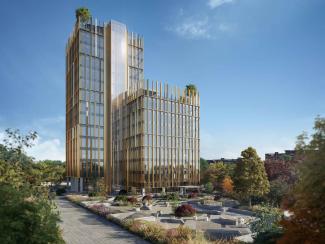AGC continues to expand production of low embodied CO2 float glass
Six months ago at its site in Moustier, Belgium, AGC Glass Europe started production of Low-Carbon Planibel Clearlite, a float glass whose CO2 footprint has been slashed by more than 40%. The production of Low-Carbon Planibel Clearlite yields no more than 7 kg of CO2 per m² for glass that is 4 mm thick. Now, the AGC site in Seingbouse, France has also started producing this same sustainable glass product, marking the next step in the planned long-term Group-wide rollout. With this additional production capacity now online, AGC has expanded its Low-Carbon Glass range to include a Low-Carbon variant of Stratobel (safety glass), Stratophone (acoustic glass), iplus (thermal insulation glass), Stopray and Energy (solar control glass), as well as toughenable coatings (T-coatings). The entire range is now available in all thicknesses from 3 to 10 mm.
AGC Glass Europe has taken the next step in its Carbon Neutrality Roadmap by enabling another AGC production facility to produce Low-Carbon Glass. The Group’s holistic approach takes the entire value chain into account: decarbonising production processes, reducing CO2 emissions from the upstream supply chain and cutting other indirect emissions. AGC is effectively leveraging the more sustainable procurement of raw materials, the use of highly efficient melting furnaces that deploy innovative electroboosting technology, the increased use of recycling via intelligent pre-consumer cullet flows and optimised transport between AGC plants and customers. The Group also promotes the use of renewable energy by not only purchasing green energy but also generating its own green solar and wind power.
Investors opt for sustainable building projects
Investors and building owners are increasingly demanding that sustainable materials be used in their projects. Sustainable buildings have a smaller ecological footprint, minimise the consumption of non-renewable resources and reduce greenhouse gas emissions. During the construction phase various aspects have to be considered, such as the use of decarbonised materials, recyclability, the reusability of building components and the reduction of waste, both during the construction process and beyond the building’s life cycle.
There are also financial arguments for investors and owners: healthy and ecological buildings deliver higher rents and sales prices, which in turn expands the potential for a long-term increase in the value of the investment. Accordingly, by pursuing sustainable asset portfolios, investors and fund managers can tackle their scope 3(1) goals, such as tenant emissions and embodied carbon, and improve their ESG credentials.
For AGC Glass Europe, the growing demand for sustainable and decarbonised construction is already being reflected in the first projects specifying AGC Low-Carbon Glass:
- UMC Research & Diagnostics Centre, Amsterdam (The Netherlands)
UMC Amsterdam has a new research and diagnostics centre, for which they specified 1,600 m2 of Low-Carbon ipasol Ultraselect 62/29 (solar control glass) and Low Carbon Planibel Clearlite (single glass). - Nervesa 21, Milan (Italy)
This 10,000 m² Grade A building in Milan is aiming for the highest ESG credentials and circular economy practices in a sustainable refurbishment process that involves recycling more than 90% of the materials removed during the renovation process and sourcing local materials. Some 6,500 m² of Low-Carbon Stratophone 66.2 and Low-Carbon Planibel Clearlite will be supplied. - Mobilis, Brussels (Belgium)
Redevelopment project by D’Ieteren Immo to create a multifunctional, innovative, flexible and sustainable building that will be both energy-neutral, with BREEAM Outstanding certification, as well as climate-proof. The facade will comprise Low-Carbon Stratobel 44.2 and Low-Carbon Stratophone 44.2. - NDR Fernsehen, Hamburg (Germany)
Around 2,000 m2 of Low-Carbon Stratobel iplus 1.1 and Low-Carbon Energy 72/38 were used in the facade of the new NDR programme building in the Lokstedt district of Hamburg.
AGC's Low-Carbon Glass is identical to the Group's conventional glass in terms of quality, aesthetics and technical values, but around 40% less CO2 is generated during the production process(2) . Interested readers can find additional information at www.agc-yourglass.com.
(1) Scope 3 emissions : indirect emissions from upstream and downstream activities along the value chain.
(2) Compared to AGC Glass Europe baseline: EPD for Planibel in the INIES database
Pictures below:
Picture 1: First production run of Low-Carbon Glass in Seingbouse, France
Picture 2: Nervesa 21, office building project in Milan, Italy. Architect: Lombardini22, Investor: Cromwell Group
Share this page
AGC Glass Europe
Valérie De Laminne de Bex
Marketing Communication
Tel : +32 2 409 32 14
Mobile : +32 492 13 64 67
valerie.delaminnedebex@agc.com
AGC Glass UK Ltd
Andrea Marston
Market Development & IBP Manager
Tel +44 (0) 1788 535353
Mob +44 (0) 7736 059 465
andrea.marston@agc.com
AGC Glass Europe, a European leader in flat glass
AGC Glass Europe produces, processes and markets flat glass for the construction industry (external glazing and interior decoration), car manufacture and other industrial sectors (transport, solar power and high-tech). It is the European branch of AGC, a world leader in flat glass. It has over 100 sites throughout Europe and employs around 13,000 employees.
More information on www.agc-glass.eu (corporate site), www.agc-yourglass.com (glass for the construction industry) and www.agc-automotive.com (for the automotive industry).

